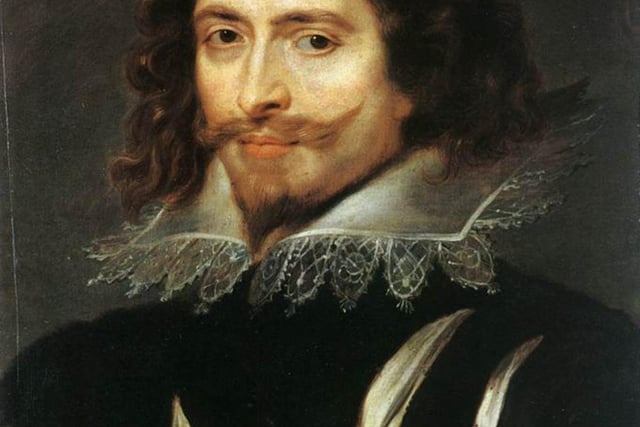George Villiers, 1st Duke of Buckingham, seriously suited tights. His portrait, painted when he was 24, shows a young man displaying an awful lot of long, elegant leg. Tall, dark and handsome, he drove the court of James VI and I wild. Yes, he was penniless, but he brightened up the view, and presumably a rich bride would be his for the wooing.
According to a new television drama about to hit our screens, George, or at least his mother, wasn't interested in a wife. Not even an heiress. They had their eyes on a much bigger prize. The king himself. James VI liked the company of good-looking young men. Esmé Stewart, Richard Preston and Robert Carr had all been close enough to James to create gossip, and resentment when he lavished money, lands and titles on these favourites.
They met in 1614. George was twenty one and James fifty. In no time at all, the king and the courtier were never out of each other's company, day or night. During the kings' progresses around the country, gorgeous George was always in attendance, no matter what time advisors dropped by for a chat.
The National Museum of Scotland holds a clue as to their relationship. It’s two stained glass panels, made to commemorate the visit of the king. A sort of ‘King James slept here’ plaque. Normally the queen would have accompanied her husband and you’d imagine that the second panel would depict Anne of Denmark, but no, it's the king’s favourite, George, Duke of Buckingham. Someone really knew how to please the in-crowd.
George was a savvy young man. He knew that his royal patron wouldn’t last forever, and so he set his sights on befriending the next in line for the throne, Charles I. Like his father, Charles had been born in Scotland, in 1600. He was a second son, the ‘spare’ to glamorous Prince Henry. His unexpected death in 1612 pushed Charles to the throne. He was considered clever enough to be king, but given to rages and impulsive behaviour, which might explain the utterly bonkers mission he and his new friend George embarked on in 1623.
Charles, as per a royal prince, had been on the marriage market almost as soon as he was born. His father was terribly keen on a match with the Spanish Infanta. Yes, there was the touchy subject of her being Catholic, but there was the happy fact that she’d bring a stonking dowry. Negotiations had been dragging on for a decade when George and Charles hit on a cunning plan.
They would go to Spain and woo the princess in person.
None of the royal trappings for Charles and George. They vowed to remain unknown and magically appear in Madrid, a bold choice in pre-Easyjet days. Even bolder when you recall that Europe was something of a warzone. Even more extraordinary, James let his heir go on this madcap road trip. Perhaps he thought it an adventure. He wrote to Buckingham in a fit of misguided romantic thinking ““my sweete boyes and deare ventrouse Knights worthy to be putt in a new romanse.”
The ‘sweete boyes’ wandered through Europe pretending to be brothers, calling themselves John and Thomas, booted and suited and dripping with cash. They disguised themselves with false beards. Why they didn’t actually grow beards is a bit baffling.
They behaved like two massively entitled lads on a gap year. They overpaid a ferryman with silver. He got suspicious, thought they were up to no good and reported them to the authorities. They nearly got busted at Canterbury until Buckingham pulled off that fake beard and said he was on secret government business. They threw up all the way on the ship to France, but they did manage to do some sightseeing in Paris. On their journey to Madrid, according to historian Glyn Redworth, they behaved like many a spoilt lad in a foreign land, nicking goats and getting into fights by being rude to people’s mothers.
At about eight o’ clock on a March evening in 1623, the British ambassador in Madrid was astonished to discover that the man standing opposite him, carrying his own baggage, was none other than George Villiers. Presumably he tore off that fake beard. Bet that was a relief. Outside stood a younger, taller man, who was revealed as Charles, Prince of Wales. These days royals can jet about at will, but even those visits are highly choreographed. The crash-landing of the heir to the throne and his sidekick in Spain was not welcome. Ambassador John Digby went ballistic, in a diplomatic manner. He said it was “sudden and unthought of”. In the language of Sir Humphrey’s civil service this means ‘this is a bad idea”.
It's possible that Charles thought he could sweep the Catholic Infanta off her feet into matrimony. In one insane moment, he lept over a wall and into the walled garden to land at the feet of his intended. The court of Spain was amongst the most rigid and regimented in Europe. This Captain Flashheart move impressed no-one. Buckingham wasn’t doing much better. He was sent to carry out some negotiations, presumably to stop him womanising right left and centre, but the talks ended when he became so enraged that he threw his hat to the ground and stomped all over it.
In any case, the 13 year old Infanta Doña María had announced she would rather take to a nunnery or die a martyr than marry a heretic. Teenagers do tend to be a tad dramatic.
The lads were recalled home. No Spanish bride for Charles, but George Villiers was still by his side, the man who beguiled two Stuart kings.

1. 3811917052_267f567c01_o (1).jpg
George Villiers, 1st Duke of Buckingham, knew the value of having friends in high places. PIC~: CC. Photo: CC